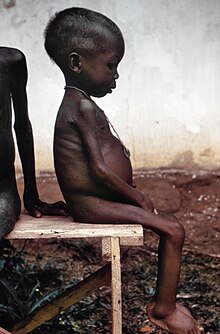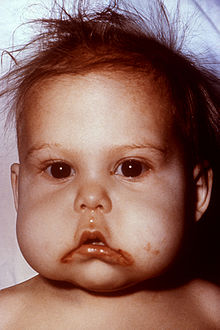Kwashiorkor
| Classification according to ICD-10 | |
|---|---|
| E40 | Kwashiorkor |
| ICD-10 online (WHO version 2019) | |

Kwashiorkor ( hunger edema ) is a form of protein - energy - malnutrition (PEM). It currently occurs mainly in children in developing countries , but was also widespread in Central Europe in earlier times. An older German term is also "flour nutritional damage".
The name was introduced by the Jamaican pediatrician Cicely D. Williams in a 1935 paper in the Lancet . In the Ghanaian Ga language , the term means “the disease that a child gets when a new child is born”.
During the Biafra war , the term "Biafra child" was coined for the sick children.
causes
The disease usually occurs after the child has been weaned from breast milk and is being fed low-protein foods. The clinical picture is particularly due to the lack of certain essential amino acids . As a result of this deficiency, there is a decrease in albumins in the blood ( hypoalbuminemia ) and a concomitant drop in the colloid osmotic pressure, with the result that tissue fluid - especially in the abdominal area - cannot be reabsorbed into the venous capillaries . However, this process only takes place in some of the children.
In 2013, the composition of the intestinal flora together with the local diet were identified as the decisive factors for the occurrence of kwashiorkor in Malawi . It was possible to cause the corresponding symptoms in mice by transferring the intestinal flora.
A relationship between the appearance of symptoms of kwashiorkor and the ingestion of aflatoxins with food is still being discussed.
Clinical manifestations
The clinical picture shows the characteristic hunger stomach, which is caused by water retention all over the body, but especially on the stomach, as well as an enlarged liver . Furthermore, skin changes occur, often discoloration of the hair, growth disorders, diarrhea and weight loss, although the latter is not as severe as with marasmus .
Strong psychological changes such as indifference and apathy can also be observed. Healed children show stunted growth even after the disease has ended. An inhibiting influence of the deficiency on mental development is not certain. The duration of kwashiorkor episodes can be estimated if the hair is long enough, as the hair grows with reduced pigmentation under protein deficiency.
pathology
Histopathologically , the findings in the liver are particularly striking. Under the microscope it shows a lot of fatty tissue. This is due to the fact that fat ingested through food accumulates in the liver cells, since not enough apoproteins can be synthesized to transport the fats into the adipose tissue. These changes regress completely with sufficient protein intake. There is no increased risk of liver disease.
treatment
The initial stabilizing treatment consists of a high-energy diet offered to the patient in small but frequent servings. This stabilization phase serves to maintain the basic physiological processes and must not overtax the severely restricted metabolism of the patient. In particular, a high protein content can have negative consequences in the first few days. Milk is particularly suitable for this initial phase and can be fed as tube feeding .
After about a week, the milk formula can be enriched. After about two to three weeks, the milk can be replaced with cereal porridge enriched with vitamins and minerals until the body weight is at least 80% of normal weight again. Then you can switch to traditional foods. A patient is considered cured when their body weight has returned to 85% of normal.
See also
literature
- V. Scherbaum, P. Fürst: Protein-Energy-Malnutrition (PEM). In: Hans-Konrad Biesalski (Hrsg.): Nutritional medicine: according to the nutritional medicine curriculum of the German Medical Association. 3. Edition. Thieme, Stuttgart 2004, ISBN 3-13-100293-X , p. 288 ff. (Partially accessible digital copy )
Web links
Individual evidence
- ↑ CD Williams: Kwashiorkor: a nutritional disease of children associated with a maize diet. In: The Lancet . 1935; 226, pp. 1151-1152. doi : 10.1016 / S0140-6736 (00) 94666-X .
- ↑ Die Welt: When Starving Children Became Symbols of the Third World
- ^ A b c Emanuel Rubin, David Strayer: Environmental and Nutrional Pathology. In: Raphael Rubin, David Strayer: Rubin's Pathology. Lippincott Williams & Wilkins, Philadelphia 2008, ISBN 978-0-7817-9516-6 , pp. 278 ff.
- ↑ MI Smith, T. Yatsunenko, et al. a .: Good microbiomes of Malawian twin pairs discordant for kwashiorkor. In: Science Volume 339, Number 6119, February 2013, pp. 548-554, ISSN 1095-9203 . doi: 10.1126 / science.1229000 . PMID 23363771 . PMC 3667500 (free full text).
- ^ RG Hendrickse. Kwashiorkor and aflatoxins. In: J Pediatr Gastroenterol Nutr . 1988; 7, pp. 633-636. PMID 3054037 .
